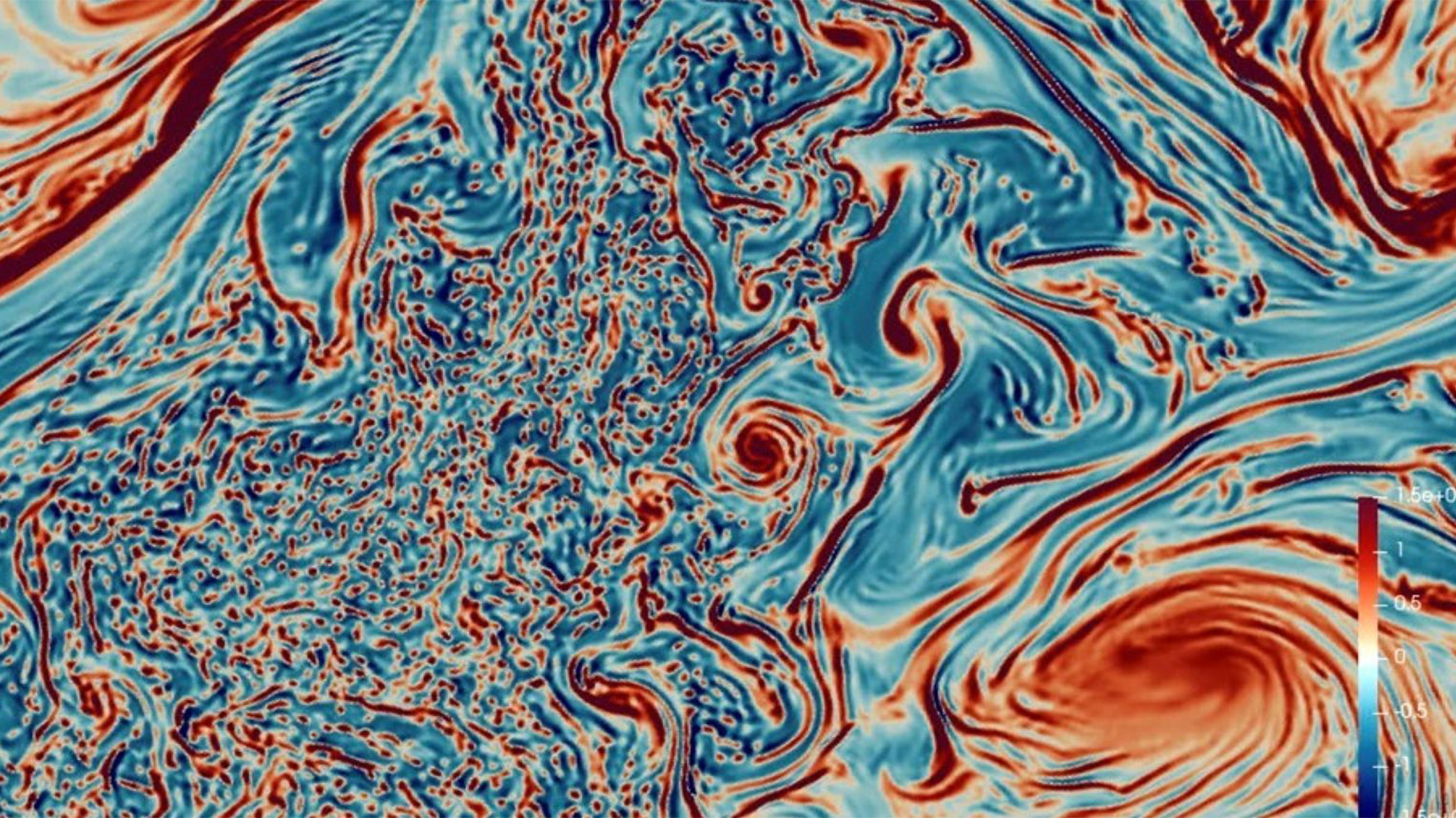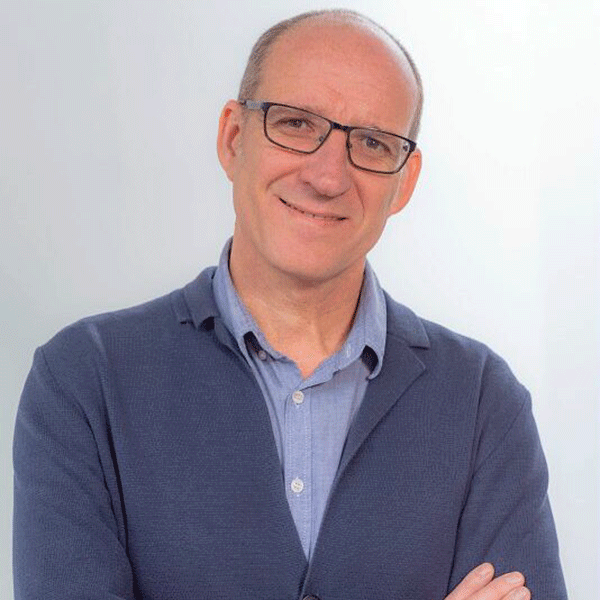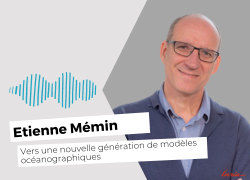Towards the next generation of oceanographic models
Date:
Changed on 30/10/2024

“Relative vorticity over planetary vorticity” in the Gulf stream region. The picture is a close-up of a global simulation with the ocean general circulation model ICON-O of the Max-Planck Institute of Meteorology.
By recycling carbon dioxide and absorbing heat, our oceans play a key role in regulating the climate. But the oceans themselves are warming, temperatures having risen more than 1.5°C compared to pre-industrial levels. The bulk of this additional energy is stored close to the surface, at a depth no greater than 700 metres, which is what makes modelling the upper layers of the ocean so important in understanding the damage caused by the greenhouse effect.
But there are limits to current oceanographic models. Although based on causal physics and relying on a level of determinism, they are also by nature chaotic, making them highly sensitive to original conditions. Small variations in these initial conditions within a model can be enough to produce different results in a relatively short space of time, resulting in uncertainty.
Seeking a solution to this problem, the European Research Council (ERC) is currently providing funding to Stuod, a project bringing together the scientists Dan Crisan, Darryl Holm (Imperial College London), Bertrand Chapron (Ifremer) and Étienne Mémin (Inria). This six-year project is set to run until 2026, and has been allocated a budget of 10 million euros as part of Synergy, an ERC programme designed to encourage exploratory research of a multidisciplinary nature.
Image

Verbatim
We believe we can develop ocean circulation models with the capacity to handle uncertainty within models. This will involve quantifying all of the approximations made in the model and tracking their progression over time
Auteur
Poste
Research Director and head of the Odyssey project-team
Generally speaking, “all models come from approximations, chiefly because they overlook small-scale processes. Furthermore, digital plans are themselves approximations of continuous operators, which obviously can’t be run on a computer, meaning things need to be discretised. A partial derivative, for instance, needs to be discretised before it can be used. And so it is digital approximations that are generated. There is also the issue of processing costs. The easiest way of limiting these is to lower the resolution, but this can result in extreme approximations with regard to the systems that are to be modelled.”
As for the uncertainty resulting from all of these approximations, “this will evolve over time, and must be characterised. The best way of doing this is to directly factor it into the model, which means building models that incorporate some representation of this uncertainty and the dynamics of it.” In pursuit of this aim, Stuod is aiming “to transition from causal deterministic physics to a random, stochastic representation of the physics at play.” In practical terms, this will involve a probability distribution being used to quantify uncertainty.
Such methods also provide an additional level of freedom. “Compared to a deterministic model, it is possible to have something very close and then devise models that gradually let go of the laws of equilibrium on which some approximations are based. In this way a range of sub-models are produced, which act as intermediaries between two deterministic models which themselves remain entirely separate. Such a continuum of representations seems to me to be desirable when seeking to process applications that are so different from each other. When studying highly specific phenomena in ocean dynamics you can't use the same tools and the same models. A change of approach is needed.”
At a practical level, the research is centred around two methods. Inria has devised a "newtonian" stochastic model that can be applied to all fluid flows, while Imperial College London has devised a "hamiltonian" model with a more limited scope. The aim for Stuod is to analyse their respective mathematical properties and build oceanographic models using these two rigorous methodological frameworks.
“We started out with idealised models, seeking to move towards realistic models incorporating these stochastic processes. The results have been quite remarkable. Within the next two years, we expect to have developed a demonstrator that will aim to incorporate this stochastic framework into an operational oceanographic model.”
Launched in 2022 and based in Rennes and Brest, Odyssey is a joint team bringing together six French academic institutions: Ifremer, IMT Atlantique, Université de Bretagne Occidentale, Université de Rennes, CNRS et Inria. The person in charge of the team is Étienne Mémin. “There are 21 permanent researchers. The group is made up of people who work closely with models and the link between observations and these models, physicists seeking to analyse certain phenomena involved in ocean dynamics, plus mathematicians whose interest is in analysing these models mathematically.”
For the past few years, artificial intelligence has also played a role in the research. “Many of the people on the team work on machine learning, each in different ways. Some are closer to models, while others focus more on data. These machine learning methods will be used either for data analysis purposes or for configuring complex processes within digital simulations. In the most extreme case, they may also be used to determine the entire dynamic model using data, in which case very little physics will be used. There are a whole host of examples through which we can try to infer the dynamics of the processes we want to observe.”
Thus far the researchers have concentrated exclusively on the ocean. “However, there is another component: the atmosphere. How the ocean interacts with the atmosphere is a fundamental part of climate models, which is why it is something we would like to tackle. The aim would be to employ the same core dynamic for both the ocean and the atmosphere as part of a stochastic model. There would then be sections driven by machine learning for the most complex physical phenomena in the ocean or the atmosphere, such as convection, ice water in the ocean, the relationship between waves and currents, etc.
This new combination of digital stochastic modelling, mathematical analysis and AI is central to the project I would like to lead in the future.”
Titre
Visuel

Titre du lecteur
Find out more about the new generation of oceanographic models (in French)
Fichier audio
Audio file
My name is Etienne Mémin. I'm a research director at Inria and head up the Odyssey team, which is a joint venture between six institutes: CNRS, two universities, the Université de Bretagne Occidentale in Brest, the Université de Rennes, INRIA, IMT Atlantique and Ifremer. So it's a team of 21 permanent researchers based between Rennes and Brest. The team's main focus is ocean dynamics, and within this framework, we are interested in problems ranging from data analysis and data collection on ocean dynamics, to stochastic or deterministic modeling of the ocean and ocean dynamics, via machine learning problems to characterize physical processes in ocean dynamics, either for analysis or modeling purposes.
Models are essential for two things. They are obviously essential for forecasting problems, either in the short term, perhaps a day, several days, several weeks, etc., or in the very long term, for climate issues. Or for very long-term climate issues, where the ocean is obviously of paramount importance. Some oceanographers are very happy with the models. Those who are involved in defining these models are quite happy with their models. Now, people who are closer to the data perhaps see a little more of the difference between reality and a physical model, and therefore perceive that there is still much, much room for improvement.
I think just about everyone agrees that, for the moment, models don't know how to deal with uncertainties, and this is the main focus of my work. These uncertainties and their dynamics, in fact, play a major role when it comes to simulating plausible realizations of the ocean's state. The Odyssée team has a great advantage in that it brings together people who are close to models, observations and the coupling between observations and models, as well as physicists working on the physical analysis of certain phenomena involved in ocean dynamics.
There are also mathematicians in Odyssey who are more interested in the mathematical analysis of these models. When we talk about stochastic models, for example, this analysis is all the more difficult because we're dealing with tools that are less common, more difficult to approach. We're introducing randomness into modeling, and aiming to move on from deterministic causal physics to a random, stochastic representation of this physics, and in particular its dynamic aspect.
What we think we can offer are models that are capable of managing model uncertainties, i.e. quantifying all the approximations made in the model and providing an image or idea of how they evolve over time. The STUOD ERC is a collaborative ERC between Ifremer, Inria and Imperial College, the aim of which is to develop stochastic models for ocean dynamics.
Inria contributes a general stochastic model that is applicable to all fluid flows. Imperial College is interested in a model that is restricted to the Hamiltonian model. The STUOD ERC aims to analyze the mathematical properties of these two types of model, and to build and derive ocean models based on these two major methodological frameworks, with a view to applying them to ocean dynamics. The ultimate aim is to build data assimilation techniques, i.e. coupling model and data, where uncertainty and the random aspect of models play a key role in methods of this type. We should be able to arrive at a final demonstrator that aims to include this stochastic framework in an operational model.